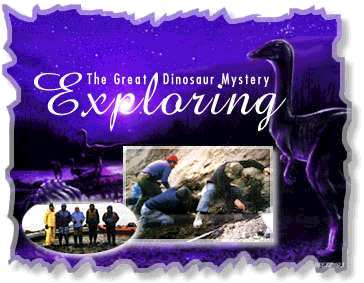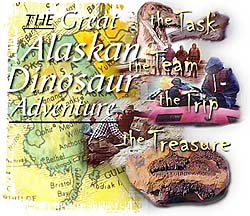
Home
Discover our Creation videos and books!
See this page in: Russian


E X P L O R I N G

Watch our popular motion picture, “The Great Dinosaur Mystery” on-line (free) - Go…
 Home Discover our Creation videos and books! |
|
See this page in: Russian   Watch our popular motion picture, “The Great Dinosaur Mystery” on-line (free) - Go… |
| |
|
 Creation scientists headed to the north slopes of Alaska to hunt for dinosaur remains. They found bones that are mostly unpetrified (very little mineralization). Read our 20 page report on this exciting expedition, complete with photographs. Join us in a journey as we learn about their discoveries, ordeals, and daily evidences of the Creator’s hand at work during their ten day expedition in the wilderness.  Have you seen our… Questions & Answers about dinosaurs | Dinosaur Discovery Trail | Resources and Tips for teachers and parents. Caught in the Act: Freeze-frame Momentos from Ancient China Gobi Desert—How were the Chinese dinosaurs fossilized by Margaret Helder If you have followed the adventures of scientists who collect fossils for a living, you may have noticed that travel to distant lands is often part of their profession. One such account by Derek Ager, published posthumously in 1993 (The New Catastrophism, Cambridge University Press) contains insights garnered from his travels and experiences during the course of a long career in palaeontology. The book contains many interesting details and some very frank remarks. One item particularly caught my eye. Dr. Ager mentioned that many people have misconceptions about deserts. He too, had expected to find endless stretches of massive sand dunes. On the contrary, he said, "most deserts are not sandy but have stony surfaces with the stones often shaped like the wind." (p. 24) Sand dunes do occur in deserts but they are usually only local in extent (p. 26). He pondered the significance of this for geology. Dr. Ager came to the remarkable conclusion that “desert sediments in the form of sand-dunes are continuously on the move and do not usually accumulate for the geologists of the future. What is more, desert animals and plants are unlikely to be preserved.” (p. 28) This opinion struck me as interesting in view of other published reports on the effects of sand storms in China. In recent years, news has been published of some very remarkable dinosaur fossils found in China. These fossils are preserved in postures that they would have occupied while alive. As far as anyone can see, these animals were overtaken by disasters so sudden, that they had no chance to escape. They have remained entombed to the present. We might well ask ourselves what happened to these animals that was so sudden and so permanent in its effects. The answer that we typically hear is that the victims were overtaken by sudden sand storms. But how reasonable, one wonders, is that conclusion. The first such fossil, long labelled the most “dramatic of all dinosaur fossil finds” was discovered in the late 1960s by a Polish lady palaeontologist. At Tugrugeen in Outer Mongolia, a site with a white sandstone escarpment, Zofia Kielan-Jaworowska uncovered "two dinosaur skeletons beautifully preserved as they died, locked in a vicious struggle". So recounted Don Lessem in 1989 (Digging for Dinosaurs in China. Rotunda v. 21 #4 p. 18). The aggressor was a small predator, Velociraptor, while the victim was a stocky herbivore Protoceratops lying on its back while the Velociraptor attacked its unprotected underside. The victim clearly was doomed—but something overtook them both, preserving the violent scene until today. So what happened to these combatants? According to Don Lessem, the lady palaeontologist speculated that the dinosaurs sank in quicksand. Others since, have reflected perhaps that at least the aggressor animal would have tried to escape from quicksand. Thus in an article in Scientific American ("Fossils of the Flaming Cliffs". December 1994 p. 66) authors Michael J Novacek and others, suggest alternatively that the “fighting dinosaurs” met their end in a sandstorm. Interestingly a fossil was found in 1987, far to the south in China’s Yunnan Province. National Geographic (January 1993 p. 24) quotes "China’s leading dinosaur paleontologist" concerning a 5 m long carnivore which was interlocked with a still larger herbivore. Dong attributes their deaths and surprising preservation to perhaps their struggling on a lake bed and their becoming bogged down in quicksand. Another recently discovered fossil “amazingly beautiful” is seeemingly a further example of instantaneous preservation. It was located at Ukhaa Tolgod, the famous Flaming Cliffs of the Gobi Desert, South Central Mongolia. As described by Mark Norell and others (Nature 21/28 December 1995 pp. 774-776), close examination of the fossil provides compelling evidence that the animal was brooding a clutch of eggs. These eggs, probably 22 in all, had most likely been manipulated by the mother into a circular pattern with the broad end pointing towards the centre of the nest. The animal appears to be squatting directly over the nest with arms slightly extended. This type of adult had been found in 1923 in close association with a nest. Roy Chapman Andrews named the animal Oviraptor or “egg stealer” because he assumed that it was robbing the nest of a Protoceratops, the most common dinosaur in the area. A similar egg however was discovered in 1994 to contain a nearly perfect oviraptorid skeleton (Scientific American December 1994 p. 68). Scientists then wondered if perhaps Andrew’s specimen had actually been incubating the nest rather than robbing it. The fossil described in 1995 indeed appears to confirm that view. Oviraptor, now known to be inappropriately named, was a dinosaur which reached 2 metres long. Its legs were designed for running. On top of its head was a strange structure, a “wildly projecting cassock.” The appearance of this animal must have been unique. The front of the skull was formed into a prominent toothless beak. Nobody has any idea now what precisely this animal ate. This specimen at Ukhaa Tolgod, and other fossils there, exhibit extraordinary preservation, the result of rapid death and burial "in what must have been a powerful sandstorm, so sudden that we are left with the impression of an animal freeze-framed in the act of nest brooding." according to commentary in Nature 21/28 December 1995 p. 765). Other fossils found at the same site include tiny mammals, so fragile one would expect the bones to be completely distorted. In this case however the skeletons were almost completely intact. Concludes the Novacek team "these small creatures were probably buried and preserved rapidly after they had died." There seems no doubt that something sudden and remarkable happened to these animals in China. As Novacek and others remark "No one knows why fossils in the Gobi are so well preserved." (p. 60) It seems apparent however, that these animals were buried quickly. They definitely were not carried along after death by treacherous water currents, as were most of the North American dinosaur fossils. Obviously these animals were overtaken by almost instantaneous catastrophes. As we have seen, scientists have variously attributed these to quicksand (wet) or sand storms (dry). The latter would be more sudden but would they be sudden enough? We now know that deserts and sand storms are probably inadequate explanations for the permanent way in which these animals were buried. Nor would most sandstorms provide the element of surprise that these incidents suggest was involved. Several creationists, alternatively, have suggested that we turn our attention to water, the other vector of sand. Indeed the Novacek team acknowledges that water was a factor in the area. "Although much of the Cretaceous Gobi was dry, water must have been abundant in at least a few places and times. We found occasional fossils of turtles, usually associated with aquatic habitats." They mention one site west of the Nemegt Valley where 50 turtles were found in a site the size of a wading pool. (p. 63) Fast moving water has the capacity to carry and deposit great loads of sediment. Water moves sediment far faster than wind can. In the wake of a tidal wave, the sediments could consolidate, within a watery milieu, into permanent tombs for the victims. Those dinosaurs in China died in sudden flooding. It was a crisis unequalled since in scope. Now why have the palaeontologists not thought of that? Scientists, researchers, writers: Do you have material that you would like to see added to this growing resource on dinosaurs? Contact our editorial team. [Dinosaur Home] |
| |

|